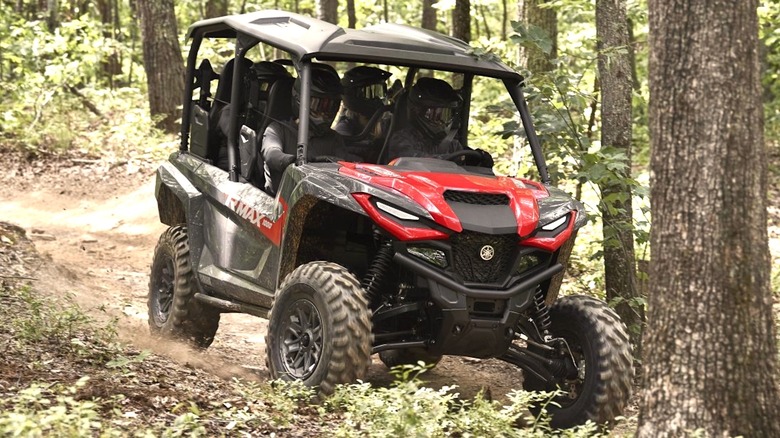What Does UTV Stand For And How Is One Different From An ATV?
For those who regularly work or play in the great outdoors, there are plenty of consumer vehicles available that are designed to help you do both. Whatever your tasks might be, some may prefer to tackle them using a vehicle with more than two wheels, and that likely means saddling up inside a UTV or on top of an ATV.
It is, however, safe enough to assume that even those folks in need of a UTV or an ATV may not actually know what those three-letter designations mean. As you might expect, they stand for completely different things, with the former acronym standing in for utility terrain vehicle and the latter being used for all-terrain vehicle.
Given the difference in the vehicle's names, you'd be right in assuming utility terrain vehicles and all-terrain vehicles generally have different uses in the field. As for UTVs like the Kawasaki Ridge, they tend to be four-wheeled and better suited to carrying heavier loads than ATVs. Likewise, they are typically designed to carry more passengers, meaning they are better at accomplishing workhorse-styled tasks on farms, ranches, and harder-to-reach worksites.
ATVs like Yamaha's YFZ450R Sport, on the other hand, are either three- or four-wheel vehicles that tend to max out at two passengers and are largely used for recreational purposes, with folks finding them ideal for traversing dirt trails and hilly terrain. However, the differences between UTVs and ATVs do not stop at usage.
UTVs and ATVs have dramatically different builds
Just to clarify a point, we'll note that some UTVs like the Polaris Xpedition are designed more for sport and recreational uses, and that ATVs can also make for great workplace vehicles on the farm and beyond. But even as the disparate vehicles are each multifunctional in their own right, their builds alone dictate both advantages and limitations in their usage, and in case there's any question, yes, the vehicles also sport dramatically different designs.
As for ATVs, they've historically come in three- and four-wheel builds, though the latter version is the more common these days. Four-wheeled ATVs are often referred to as "four-wheelers" because, well, they have four wheels just like UTVs do. However, ATVs are more motorcycle-inspired in their design, with riders sitting in a straddle seating position.
They also require riders to use handlebars to steer and often have both a handlebar-mounted throttle to accelerate and a handlebar-mounted brake to slow down. Just like motorcycles, seating capacity on ATVs is typically restricted to two people, one in the driver's position and the passenger seated behind them.
UTVs are far more golf cart-like in their appearance and are often called side-by-side vehicles due to their side-by-side seating style. Unlike ATVs, UTVs are manufactured with no fewer than four wheels. They also have car-styled steering wheels, as well as separate pedals for acceleration and braking, with some even offering enclosed cabins.
As for their off-road capabilities, UTVs can vary between two-wheel and four-wheel drive, depending on make, model, and trim package. UTVs can also be built to carry more than two passengers, with some side-by-sides offering seating for up to six individuals.

